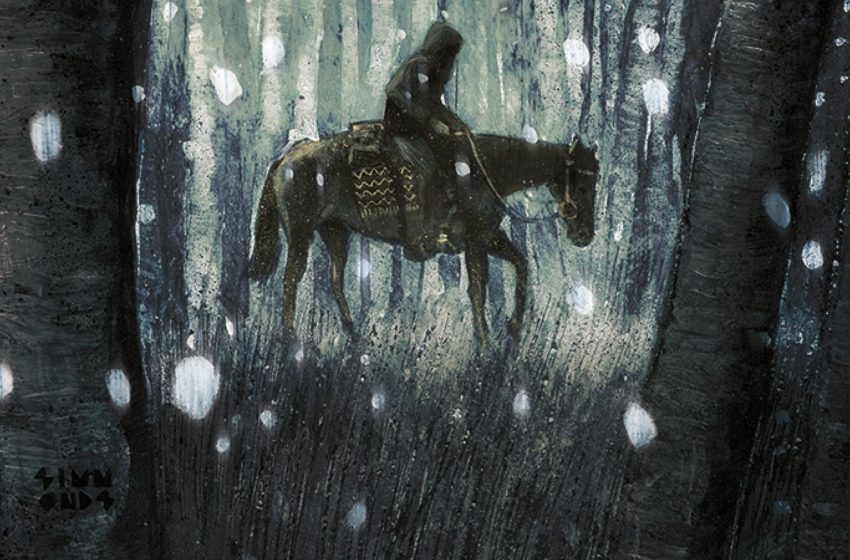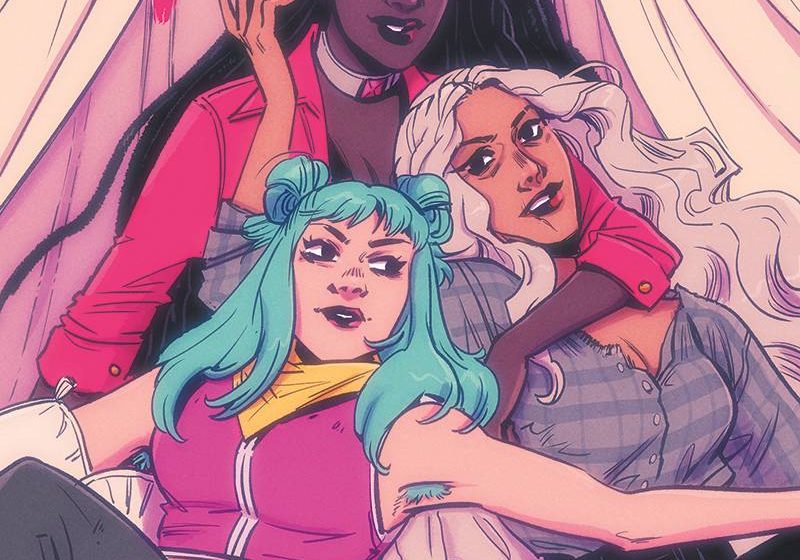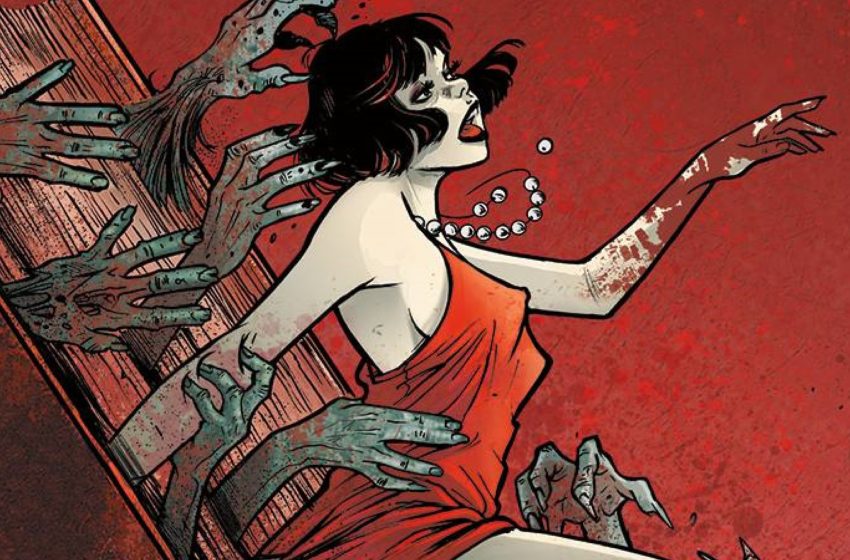Long after the rock out of space struck the world and turned it all to dust, in Bakerstown stands the last radio station on the planet. Radio Apocalypse broadcasts into the unknown, a beacon in the dark for those who wander the lost places. Now change is coming to Bakerstown in Radio Apocalypse #1, written by Ram V, drawn by Anand RK, colored by Anisha, lettered by Aditya Bidikar and designed by Tim Daniel.
Forrest Hollingsworth: Cassie, the world is ending beyond your control (probably Mark Zuckerberg’s fault) and you have five, maybe 10 minutes to listen to one final song. What’s your soundtrack to the end times?
Cassie Tongue: Forrest, this is the most stressful question I’ve ever been asked in my entire life, because I don’t know what to choose! And this is unusual for me: I soundtrack moments. I have a playlist for the moment the plane takes off from the tarmac and you touch the sky. I have a playlist for how it never gets old when you’re in the city and you turn a corner and there’s the Sydney Opera House, rising out of the water like an impossibility. I have a playlist for first crushes and reading old love letters and cleaning my kitchen and a playlist of 1960s girl groups that can turn my whole day around. I have a playlist for everything except this. To farewell life — all music, all sound — with just one song?
And yet, now that I’ve created an entire paragraph to get out of answering the question, I now know the only one it could ever be. Play me “Somewhere Over the Rainbow,” give me that heartbreaking young Judy Garland, a song I’ve loved with my whole body since I was a baby, and I’ll hope to wake up where the clouds are far behind me.
Forrest: For my money? “Right Where It Belongs” by Nine Inch Nails, my first or second most favorite band. An understated, poetic song about right and wrong and finding a place between them. It’s a little sad and a little hopeful, and the way the melody and vocals slowly creep up from the fuzzy static of the first half to the breakthrough in the last moments really hits me like I’m hearing it for the first time every time.
Here’s hoping the only remaining radio station in the wasteland, Radio Apocalypse, eponymously named for Ram V and Anand RK’s newest book from Vault, would have it …
What do you say we dive in and see if that’s even a possibility?
Cassie: Quick, before dark.
Setting the Stage
Forrest: So, starting with a literal needle drop, Ram and Anand set up the world of Radio Apocalypse across a few highly effective, densely detailed little vignettes of survivors of the apparent apocalypse tuning in. There are soldiers, cooks, farmers, scavengers called “rusters” and a few calamity-stricken kids trying to make it to the safety of civilization, Bakerstown.
You get an immediate impression of the world, its rules and its state both visually and narratively, but I was a little perplexed by the “actual” setting as it were. There’s stuff like Cali’s full name, California, as well as Springsteen fans hinting at this being a post-apocalyptic America, but I couldn’t find an exact mapping to Bakerstown and the parallel sanctuary, Kinscreek, anywhere. It could be California, but it could just as easily be Pennsylvania or Virginia. Obviously, the narrative intent is that it’s a kind of amalgamation of America that could be anywhere, but that doesn’t dismiss my desire for the crunchy details.
Cassie, as someone living outside The States, did you have the same impression, or am I putting too much thought into it?
Cassie: “Anywhere, USA” is almost as real a location to me as a lot of places in the U.S. — we have a lot of imported pop culture and media over here! — so actual cartography, a strict location, is not necessarily important to me when falling into a story like this one. What I respond to most when I read a comic, searching for a sense of place, is how it looks, how it feels, how characters move within it. Bakerstown and its surroundings actually kind of remind me of a place I lived growing up — the drought-stricken shriveled scrub and packed red earth of what you would probably call the outback (Think of the Mad Max movies — that’s exactly the spot I mean). There’s a similar sense of sparseness and deprivation. There’s not a hint of green in that landscape; just looking at Anand RK’s panels could make you parched.
The issue is full of signposts like this: immediate, sensory-driven shortcuts to building a new world that tell you that wherever we are — everywhere, nowhere, somewhere you know only changed — things are really not OK.
I was particularly struck by the expansive sky, how just about each page makes sure we’re aware of the light changing. We find out why quite quickly (The beasts come out at night; it’s important that we understand timing is critical), but by ensuring that we can always return to views where we can see the sky, the comic keeps us looking up and out. The literal “bigger picture” cannot be escaped.
This issue is full of jangled nerves and high stakes and too-fast heartbeats that give way to drums. And it’s all anchored in big sky, hard ground and a discernible lack of safe places to hide. It’s a ride and a half.
Forrest: That’s a really acute observation! Whatever has happened here, whatever specific way in which the world’s people and civilizations broke, it doesn’t seem to have affected nature much. It kind of shepherds us back to a very natural and literal survivor state, which is good for the heightened interpersonal drama the book introduces in its last act.
To that end, what do you make of the antagonistic aliens or “Xinos?” I love the name, a very simple play on “xenos” but also one that evokes something a little more culturally based, like Mexico’s Xoloitzcuintli dog breed.
Cassie: It looks like, whoever those guys are, they came down with a nasty case of Inside-Out Fog.
I appreciate how quickly and efficiently they are introduced; in just a glance we understand how this threat is one that could leave us with just one radio station to bring us anything other than the sound of our own terror.
This whole issue is a great study in efficiency; in just a few pages, it’s upsetting to see a character we’ve just met in danger from these aliens — it’s a quickly sketched character who feels real enough to elicit concern from a tender-hearted reader (We’re all a little tender-hearted, right? Comics are stories for people with big dreams and big hearts, after all).
Forrest: You might have a bigger heart than me, but, for what it’s worth, I’m counting the radio station having Muse’s Blackout as a likely indicator that they would also have some NIN. Score one, I’m doing the best at this.
Synesthesia
Forrest: As interesting as narrative implications of the world here are, we would be remiss not to talk about Anand RK’s amazing, dense and evocative art. There’s admittedly a lot going on with the scratchy, loose linework layered on top of blocky colors and filmic-inspired bokeh and burn-in effects, but I think it comes together quite well, and strangely beautifully for the end of the world.
Cassie, is this an apocalypse you could see yourself getting by in?
Cassie: I have mad first aid skills, but I’m also a gentle asthmatic writer who can’t drive, so I don’t think I’m surviving any apocalypse (Don’t tell the aliens, OK?) But I do occasionally do some radio spots, so I think I’ve found my niche: I’ll spin your NIN records and the 7½ -minute version of Celine Dion’s “It’s All Coming Back to Me Now” into the hopeless air.
Forrest: An interesting note is that the look, both in delivery and in overall aesthetic approach, has changed kind of significantly since the book was first previewed.
You can see the original preview (sourced from Comics Beat) here:
And the page as it’s actually delivered in our copy here:
Some of the linework was obviously retained, but I find the effect to be pretty different from a grounded and naturalistic brown, green and relative visual flatness to the published version’s highly emphasized, dynamic and almost fantastical approach. What do you make of the changes?
Cassie: I’m so excited and energised by these changes and this now-established visual language of the story — which you’re right, has a lot going on, but there’s room for it. Anisha’s skewed palette that embraces oranges, pinks and blue-greens suggests that something has shifted. This is no longer the world we know, right? Light hits surfaces differently when there are no lights or urban sprawl, and when our environment and resources change, the weather changes, and then aliens are here and the sky is falling and suddenly of course it makes sense that the colours have shifted into something that’s nearly unreal.
Because how can you process what’s happened to the world as real? New normals land harder than the old lived-in ones. Pink aliens and purple skies and colour that says, “Life is different, but there’s life here still” is all a bit of a thrill.
Honestly, it feels close to music.
Forrest: I love your takeaway here, and revisiting the two takes given the assessment, I think I find that what’s most revitalized is that individualized weight and significance to every object.
The hyper-stylized colors and renders of the different things littering the DJ’s table in the published version seem more at odds with each other on first glance, but in a way that’s more harmonious than the first’s relative similarity. They’re contributing to the scene that the desk is, to the character work and worldbuilding therein. There are countless examples across this, little asides and monuments to scenebuilding like the farm, the gates of Bakerstown and the gas station, too. It’s a sad, good song … not unlike NIN’s “Right Where It Belongs.”
Hitting the Beats
Forrest: OK, last but certainly not least is the actual arc of the narrative here. We’re introduced to a radio DJ, his unexpecting assistant Rion, who we know will be a main character from the book’s preview synopsis, a couple of kids — one of whom doesn’t make it — and a capable but weary outfit of soldiers and guards maintaining Bakerstown. They follow their own individual paths, but the overall notion is that they’re going to come together much more closely as the citizens of the neighboring Kinscreek make their way, en masse, to Bakerstown.
I have to say that while I’m intrigued by the worldbuilding and the multimedia approach to the storytelling, I wasn’t all that immediately invested in the cliffhanger or its preceding moments. There’s a lot going on in this first issue, but it almost seems like the one that’s meant to have the biggest effect took place entirely off panel. Is that how it reads to you?
Cassie: I mentioned before how efficient I found the storytelling: It’s a sturdy setup and a sharp construct, dropping us in somewhere new that feels different while ensuring it’s not off-putting to a reader. It’s an underappreciated skill, delivering this much information without making a reader work for it.
Having said that, efficiency does not always equal immediate immersion. I wanted more radio to go with my apocalypse; I wanted more time with characters; I wanted — I suppose — for the team to lay more cards on the table. I wanted to feel for the people as much as I tasted the air of the world. I assume that’s coming, and we can’t have it all in a first issue. But I feel like I followed that couple of kids into this world, and as the storyline shifts away from them, I’m not quite sure where we’ll go next.
That’s the trouble with a world ravaged by aliens, right? You don’t know who you’re going to be left with.






